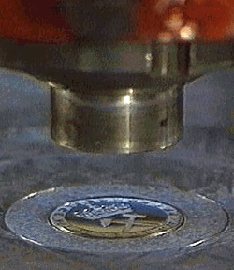

The design and production of dies is a carefully planned process. The Central Bank of Norway has an advisory coin-striking committee, chaired by the Director of the mint, with expertise on heraldry, numismatics, history and art. The first proposals are sketches and drawings. Plaster models are then made, followed sometimes by tests with trial strikes on metal.
When all the details have been worked out, the engraver starts his work based on a large positive plaster model. From this large positive, a negative model is made – the reduction model. Then, all details are mechanically transferred to a positive die of the correct size – a patrix – that is subsequently hardened. The patrix is used to make the negative die, the die that is actually used for coin production.
Click on one of the video icons below, and you will see how coins are produced today at the Royal Norwegian Mint at Kongsberg.
 Engraving of dies for striking
coins.
Engraving of dies for striking
coins.
 The production of a five-krone
anniversary coin.
The production of a five-krone
anniversary coin.
 The production of ordinary coins
for circulation.
The production of ordinary coins
for circulation.


